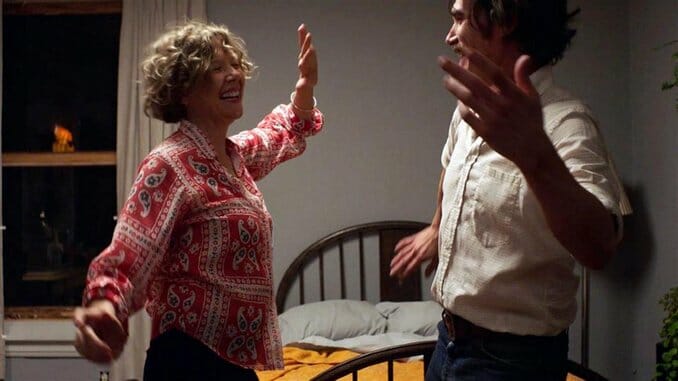What Dancing to Talking Heads Means for Your Movie

Spike Lee’s 2020 film David Byrne’s American Utopia is a filmed counterpart to the Talking Heads frontman’s Broadway show. Lee effectively incorporates immersive elements of the theater experience into the film by focusing on the hollering, dancing audience members seated in the Hudson Theater’s Orchestra. The visibility of the theatergoers interacting with Byrne and his accompanying musicians—in all their synchronized choreography and charcoal suited glory—gives at-home viewers the opportunity to witness other enthusiastic Talking Heads fans, simulating the experience of witnessing the live show. David Byrne’s American Utopia, like its classic predecessor, the 1986 Talking Heads concert film Stop Making Sense, falls into a legacy of films that capture the affinity people have with the music of the Talking Heads.
Sometimes Talking Heads songs like “Once in a Lifetime” are used to foreshadow a film’s meditations on suburban disillusionment—the song plays during the opening sequence of Down and Out in Beverly Hills as a well-to-do couple finds a houseless man attempting to drown himself in their luxurious backyard pool—and, other times, songs like “This Must Be The Place” score a moment of celebration, like in Lars and the Real Girl when Lars (Ryan Gosling) dances with his girlfriend at a party. But in films like 13 Going on 30 and 20th Century Women, central figures are partially characterized through their love of an “obscure” band like Talking Heads. Although it may not be a fully realized capital-T Trope (like the algorithm-on-the-window scene in movies about start-ups, for example), having an affinity for the Talking Heads’ music is often a character trait used in films to communicate a character’s feelings of non-belonging, difference or peculiarity when compared to other figures in the world of the film.
In 13 Going on 30, the younger version of Mark Ruffalo’s Matt (Sean Marquette) is shunned by the Six Chicks, a group of popular teenage girls whom his best friend Jenna is desperate to be approved by. While at Jenna’s 13th birthday party, Matt is asked to put on some music for the party guests. He plays a tape of the Talking Heads’ “Burning Down the House,” to the chagrin of the technicolor-clad popular children. Matt dances unabashedly in the middle of this New Jersey suburban home to Byrne’s staccato, stuttered delivery of the lines “I’m an ordinary guy / Burning down the house!”
The use of the song is effective for multiple reasons. First, it serves to contrast Jenna’s adoration of pop singers like Rick Springfield and Michael Jackson, further expanding the sonic landscapes within these opening ‘80s-set scenes. It also communicates that despite his ostracization and otherness, Matt is literally willing to dance in the face of scrutiny. “Burning Down the House” is a weird, fun song that, like “This Must Be the Place,” is now understood to be auditory catnip for people who want to dance at parties. If you don’t believe me, may I remind you of the front-row dancers who attended American Utopia? Hindsight bias and any familiarity the audience may or may not already have with the Talking Heads makes it clear that despite the stiff upper lips, letterman jackets and the disapproving glares of his peers, Matt dares to publicly luxuriate in this new wave music—but more so in his own personhood.
Similarly, in 20th Century Women—Mike Mills’ cinematic ode to mothers and mid-’70s southern California memories—a character’s love for the Talking Heads is used once more to demonstrate their difference. The film centers Dorothea (Annette Benning), a woman who relies upon the younger women in her life to help her raise her teenage son Jaime (Lucas Jade Zumann). In an early sequence in the film, crimson-haired punk photographer Abbie (Greta Gerwig) dances to “Don’t Worry About the Government.” As she punches the air and swivels around the room she rents in Dorothea’s home, Byrne sings “Loved ones, loved ones visit the building / Take the highway, park and come up and see me / I’ll be working, working but if you come visit / I’ll put down what I’m doing, my friends are important.”
-

-

-

-

-

-

-

-

-

-

-

-

-

-

-

-

-

-

-

-

-

-

-

-

-

-

-

-

-

-

-

-

-

-

-

-

-

-

-

-








































